Authors
Bonnie S. Glaser

Bonnie Glaser is director of the Asia Program at the German Marshall Fund of the United States. She was previously senior adviser for Asia and the director of the China Power Project at the Center for Strategic and International Studies. She is concomitantly a non-resident fellow with the Lowy Institute in Sydney, Australia and a senior associate with Pacific Forum. Glaser has worked for more than three decades at the intersection of Asian geopolitics and US foreign policy. From 2008 – mid-2015 Glaser was a senior adviser with the Freeman Chair in China Studies, and from 2003 to 2008, she was a senior associate in the CSIS International Security Program. Prior to joining CSIS, she served as a consultant for various US government offices, including the Departments of Defense and State. Glaser has published widely in academic and policy journals, including The Washington Quarterly, China Quarterly, Asian Survey, International Security, Problems of Communism, Contemporary Southeast Asia, American Foreign Policy Interests, Far Eastern Economic Review, Korean Journal of Defense Analysis, New York Times, and International Herald Tribune, as well as numerous edited volumes on Asian security. She is currently a board member of the US Committee of the Council for Security Cooperation in the Asia Pacific, and a member of both the Council on Foreign Relations and the Institute of International Strategic Studies. She served as a member of the Defense Department’s Defense Policy Board China Panel in 1997. Glaser received her B.A. in political science from Boston University and her M.A. with concentrations in international economics and Chinese studies from the Johns Hopkins School of Advanced International Studies.
Articles by Bonnie S. Glaser

US - China
September — December 2022The Bali Summit: US and PRC Leaders Attempt to Arrest the Slide
Joe Biden and Xi Jinping met in person for the first time as national leaders at the G20 summit in Bali and agreed to manage competition in their relationship responsibly and restore regular dialogue between senior officials and cooperation between their countries. Bilateral meetings between senior officials in charge of climate, finance, trade, and defense followed. After the US announced another weapons sale to Taiwan, however, Beijing halted the resumption of military-to-military exchanges again. The US issued new export controls aimed at freezing China’s advanced chip production and supercomputing capabilities. President Biden maintained that he would send US forces to defend Taiwan if attacked and repeated that whether the island is independent is up to Taiwan to decide. The Biden administration issued its National Security Strategy, National Defense Strategy, Nuclear Posture Review, and Missile Defense Review. The US imposed sanctions on Chinese officials for serious human rights abuses in Tibet and arbitrary detention of Falun Gong practitioners. China retaliated by sanctioning two former Trump administration officials.

US - China
May — August 2022US-China Relations Sink Further Amid Another Taiwan Strait Crisis
Nancy Pelosi’s August visit to Taiwan—the first visit by a speaker of the US House of Representatives in 25 years—was met by a strong response from China that included provocative military exercises, punitive economic measures against Taiwan, and the suspension and cancellation of a series of dialogues with the United States. Just prior to Pelosi’s visit, Presidents Joe Biden and Xi Jinping held their fifth virtual conversation since Biden’s inauguration. Secretary of State Antony Blinken delivered a comprehensive speech on the administration’s China strategy in late May. Biden officials debated whether to lift some of the tariffs imposed on China under the Trump administration, but as of the end of August, there was no decision to do so. Human rights remained on the US agenda, with statements issued on the anniversary of the June 4, 1989 Tiananmen massacre and on the 25th anniversary of the handover of Hong Kong to the PRC, and a ban imposed on imports into the US of products made by forced labor in Xinjiang. US Secretary of Defense Lloyd Austin held his first face-to-face meeting with Chinese Defense Minister Wei Fenghe at the Shangri-La Dialogue in Singapore.
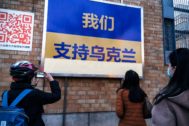
US - China
January — April 2022Putin’s War Further Strains US-China Ties
US-China relations sank to new lows in the opening months of 2022. The year began with a diplomatic boycott of the Beijing Winter Olympics by the US and nine other countries that objected to PRC policies against the Uyghurs in Xinjiang, with another five countries citing the pandemic as the reason for not sending government representatives. A meeting between Chinese leader Xi Jinping and Russian President Vladimir Putin on the eve of the Olympics produced a lengthy joint statement that highlighted the depth and breadth of the China-Russia strategic partnership and raised alarm in Washington as well as in European capitals. US-China ties soured further when the Biden administration shared intelligence with Beijing revealing that Moscow planned to invade Ukraine, but instead of seeking to prevent the war, China gave the information to Russia and refused to act. Once war broke out, US officials warned China repeatedly against providing material support to the Russian economy or military. The Chinese refused to criticize Russia, however, and instead blamed the war on the United States. US and Chinese defense chiefs held their first—and long overdue—phone call. At every opportunity, Chinese officials warned the US to stop supporting Taiwan independence. The US sent several senior delegations to Taiwan, approved the sale of $100 million in equipment and services to support the Patriot Air Defense System, and sailed three warships through the Taiwan Strait.
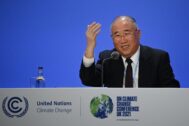
US - China
September — December 2021US and Chinese Leaders Jaw-Jaw
Joe Biden and Xi Jinping held a lengthy virtual meeting to discuss the bilateral relationship and agree on the importance of managing their competition responsibly. Demonstrating that the US and China can cooperate, the two countries signed a bilateral agreement on a common climate change agenda at COP26. USTR Katherine Tai rolled out the administration’s China trade policy. The US announced that it will not send an official delegation to the February 2022 Beijing Olympics. A few meetings were held between the US and Chinese militaries to discuss policy and operational matters. The US and its allies strongly condemned Hong Kong’s legislative elections held under new rules imposed by China that allow only “patriots” to run for office. Taiwan remained the most serious source of US-China tensions with strong warnings by both sides against challenging the interests of the other. After almost three years, Huawei Chief Financial Officer Meng Wanzhou was allowed to return to Canada in a deal struck between Meng’s lawyers and the US Department of Justice. Beijing released two Canadians who had been detained as retaliation for Meng’s arrest, and put them on a plane for Canada.
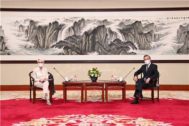
US - China
May — August 2021The Descent Continues
The downward slide in US-China relations continued as the two countries wrangled over Hong Kong, COVID-19, Taiwan, the South China Sea, Xinjiang, and cyberattacks. US Deputy Secretary of State Wendy Sherman and Chinese officials met in Tianjin but appeared to make no progress toward managing intensifying competition between the two countries. The US rolled out a series of measures against alleged Chinese forced labor practices and strengthened the prohibition against US investments in the PRC’s military industrial complex. Deteriorating freedoms in Hong Kong prompted the Biden administration to impose more sanctions on Chinese officials and issue a business advisory warning US companies of growing risks to their activities in Hong Kong.
Beijing retaliated by imposing sanctions on US citizens under its new Anti-Foreign Sanctions Law. In close coordination with its European allies, the US condemned the PRC’s use of criminal contract hackers to conduct unsanctioned cyber operations around the world, including attacks on Microsoft’s Exchange Server in March 2021. Chinese and US officials in charge of trade and economic relations held virtual meetings, but tariffs imposed by both sides during the Trump administration remained in place. Biden officials maintained that they are conducting “a robust, strategic review” of the US economic relationship with China. As the Taliban assumed control in Afghanistan, US and Chinese officials exchanged views, but the prospects for coordination and cooperation appeared dim.
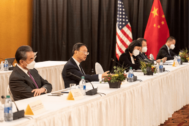
US - China
January — April 2021Continuity Prevails in Biden’s First 100 Days
In its final days, the Trump administration took more actions to impose costs on China for its objectionable policies and to tie the hands of the incoming Biden team. The first 100 days of President Biden’s administration revealed substantial continuity in policy toward Beijing, with strategic competition remaining the dominant feature of the US-China relationship. Senior Chinese officials delivered speeches that pinned blame entirely on the US for the deterioration in bilateral ties. A round of combative, yet serious, talks took place between senior US and Chinese officials in Anchorage, Alaska. The US added new sanctions on Beijing for undermining Hong Kong’s autonomy. In coordination with its allies, Washington imposed sanctions on Chinese individuals deemed responsible for carrying out genocide and crimes against humanity in Xinjiang. Steps were taken by the US to demonstrate “rock-solid” support for Taiwan in the face of stepped-up Chinese coercion. Cooperation on climate change was launched with John Kerry’s visit to Shanghai to meet with his counterpart Xie Zhenhua, and Xi Jinping’s participation in the US-led Leaders Summit on Climate.

US - China
September — December 2020Joe Biden is Elected President Amid a Plummeting US-China Relationship
In the final months of 2020, the Trump administration took a dizzying number of measures aimed at accelerating economic decoupling, curtailing Chinese Communist Party influence activities in the US, punishing Beijing for undermining Hong Kong’s autonomy and carrying out human rights abuses in Xinjiang, and strengthening ties with Taiwan. The US even attempted to ban TikTok and WeChat from the US market. China took its time, but finally congratulated Joe Biden and Kamala Harris on their victory in the US presidential election. Both the US and China launched their COVID-19 vaccination campaigns. A new dialogue was launched between US and Chinese militaries on crisis communications, but the PLA later refused to attend an annual meeting of a longstanding mechanism on operational maritime safety.
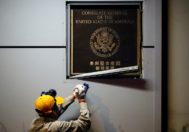
US - China
May — August 2020US-China Relations in Free Fall
President Trump blamed China for the spread of the coronavirus, which opened the door to tougher US policies on a range of issues from Hong Kong to Xinjiang. The Phase One trade deal remained intact, although Chinese purchases of US goods lagged targets in the agreement. Senior Trump administration officials delivered a series of speeches that condemned Chinese policies and suggested that the CCP poses an unacceptable threat to the United States and other democracies. Charging that the Chinese consulate in Houston was engaged in espionage, the US demanded it be closed. Beijing retaliated by shutting down the US Consulate in Chengdu. The US aligned its South China Sea policy more closely with the July 2016 tribunal ruling and declared China’s “nine-dash line” claim and actions based on it to be illegal. Tensions increased over Taiwan as the US took several steps to strengthen ties with Taipei and deter Chinese coercion. China’s imposition of national security legislation in Hong Kong resulted in the US levying sanctions on Hong Kong officials and the suspension of most US bilateral agreements with the former British Colony. A meeting between Secretary of State Mike Pompeo and Chinese Politburo Member Yang Jiechi in Hawaii did little to slow the downward slide in US-China relations.
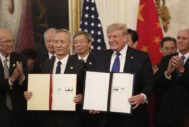
US - China
January — April 2020US-China Relations Hit New Lows Amid Pandemic
The COVID-19 virus sent US-China relations into a tailspin as 2020 opened. Recriminations flew over who was responsible for the virus that killed hundreds of thousands of people and brought economic activity to a halt. The Trump administration took a series of measures against Chinese media organizations and journalists in the United States, which provoked Beijing to expel US journalists working in China. The Phase 1 trade deal was signed, and some tariffs were lifted, though the COVID-19 outbreak hampered China’s ability to purchase the promised amount of US goods and services. With the 2020 US presidential election picking up speed, Trump campaign strategists are actively targeting China.
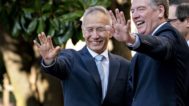
US - China
September — December 2019“Phase One” Trade Deal Reached, But Unlikely to Defuse Tensions
The US and China reached a “phase one” trade deal that includes low-hanging fruit and postpones contentious issues. Sources of friction in the bilateral relationship included President Donald Trump’s signing into law the Hong Kong Human Rights and Democracy Act, US Navy operations enforcing freedom of navigation in the South China Sea, US support for Taiwan, and China’s arbitrary detention of Xinjiang Uighurs in internment camps. A tweet by the NBA’s Houston Rockets general manager supporting protesters in Hong Kong triggered an unexpected controversy. Top US and Chinese defense leaders met on the margins of the ASEAN Defense Minister’s Meeting-Plus in Bangkok and a joint humanitarian rescue and disaster relief exercise took place in Hawaii. The US continued to take measures to crack down on Chinese espionage.